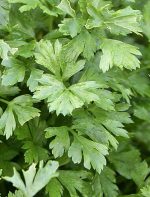 Parsley is a biennial and a member of the carrot family, Apiaceae, that also includes celery, dill, and Queen Anne’s lace. It is native to the Mediterranean area from Spain east to Lebanon and is widely cultivated elsewhere. There are three main varieites of parsely: flat leaf (Italian), curly leaf, and parsnip rooted (Hamburg). Plants grow up to 18″ tall and form a rosette of leaves with a deep taproot the first year followed by flowering stems in the second year. The tripinnate leaves are either flat or curly, up to 10″ long, and have many leaflets up to 1″ long. The tiny greenish flowers have five petals and are produced in umbels in early summer. Parsley plants are hardy in zones 5-9 and like full sun to partial shade and fertile, moist, well-drained soil. Propagation is by seed that should be soaked for 24 hours before sowing and is very slow to germinate. The genus name, Petroselinum, comes from the Greek word petros meaning rock, and selinon, the Greek word for celery. The specific epithet, crispum, is the Latin word meaning curly.
Parsley is a biennial and a member of the carrot family, Apiaceae, that also includes celery, dill, and Queen Anne’s lace. It is native to the Mediterranean area from Spain east to Lebanon and is widely cultivated elsewhere. There are three main varieites of parsely: flat leaf (Italian), curly leaf, and parsnip rooted (Hamburg). Plants grow up to 18″ tall and form a rosette of leaves with a deep taproot the first year followed by flowering stems in the second year. The tripinnate leaves are either flat or curly, up to 10″ long, and have many leaflets up to 1″ long. The tiny greenish flowers have five petals and are produced in umbels in early summer. Parsley plants are hardy in zones 5-9 and like full sun to partial shade and fertile, moist, well-drained soil. Propagation is by seed that should be soaked for 24 hours before sowing and is very slow to germinate. The genus name, Petroselinum, comes from the Greek word petros meaning rock, and selinon, the Greek word for celery. The specific epithet, crispum, is the Latin word meaning curly.
In ancient times only the flat leaf variety of parsley was probably known. Because flat leaf parsley resembles a poisonous weed people hesitated to eat it but once curly parsley came to notice, the herb earned more acceptance. The ancient Greeks used it in funeral ceremonies and in wreaths for winning athletes while the ancient Romans recognized its positive effects on bad breath and indigestion. In the Middle Ages it was used to cure a large range of ills but was probably also used as a culinary herb and Charlemagne grew a lot of it on his estates.